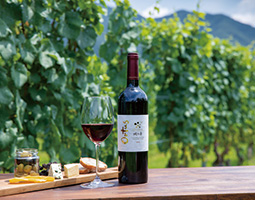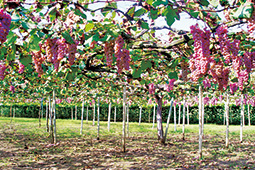INDEX

Takano Masanari (left) and Tsuchiya Ryuken 
A vineyard in Katsunuma, a leading area of grape cultivation in Yamanashi 
A red wine made in the Katsunuma region of Koshu 
Koshu grapes
September 2020
The Delicate Flavor of Koshu Wines

It is said that the cultivation of grapes in Japan began more than a thousand years ago, but the production of wine from grapes only began after the start of the Meiji period (1868–1912). Nowadays, this wine is exported globally and has received critical acclaim.

Yamanashi Prefecture boasts the highest yield of grapes and production volume of wine in Japan, and in 2013, “Yamanashi”* was declared the first geographical indication in Japan for wine by the Japanese government. There are currently around eighty wineries in the prefecture, and a little less than half of those are located in the Katsunuma region of the city of Koshu.
Katsunuma is over 100 km west of the central part of Tokyo, located to the east of the Kofu Basin that expands out northward from Mt. Fuji. Far from the sea, the Kofu Basin sees little rain and receives many hours of daylight, and so grape cultivation has prospered in the area since ancient times. The grapes cultivated here are the Japanese native Koshu variety and, having been here since long ago, they are well suited to the climate of Yamanashi. Now cultivated for the production of white wine, the grapes further benefit from the large temperature difference between day and night.

About 140 years ago in 1877, right after Japan began to modernize, there was an opportunity to begin authentic wine production in Japan. A private wine company called the Dainippon Yamanashi Wine Company was established in Katsunuma, and two young men, Takano Masanari and Tsuchiya Ryuken, were sent to France to study wine making there.
Anzo Mitsuhiro, chairman of the Yamanashi Prefecture Wine Manufacturers’ Association and General Manager / Chief Winemaker at Château Mercian, which has its roots in the Dainippon Yamanashi Wine Company, says that “Wine production in Japan was actually also a governmental national policy at the time.” He says that at the time, there was a shortage of rice due to civil unrest and a poor harvest, so the government sought to control the consumption of rice, an ingredient in sake, through expanding wine production.

When Takano and Tsuchiya returned to Japan from France, wine production began quickly, but it didn’t sell well in Japan, as Japanese people weren’t accustomed to the taste of wine, and the company was finally driven to bankruptcy. But the two men left behind their knowledge of grape cultivation and wine making to the local people, and through that, they opened a path for many wineries to later emerge in Katsunuma.
A variety of wines are made in Katsunuma, including white wine made with Koshu grapes that offers a mild flavor and a red wine made from Muscat Bailey A grapes with an aroma reminiscent of strawberries and a mild astringency from the tannins. One variety that is especially popular is a dry white wine made from Koshu grapes called Koshu Sur Lie**. The wine, with its light, fruity aroma and clear acidity pairs extremely well with Japanese cuisine. Anzo says, “The pairing of Koshu Sur Lie with Yamanashi’s famous simmered shellfish, such as nigai (abalone boiled in soy sauce) or hamaguri-no-ushiojiru (a clear hard clam soup made with rich dashi stock), is exquisite.”

In recent years, Yamanashi wine has increasingly received recognition globally. In 2010, Koshu grapes were registered as the first Japanese grapes for use in wine making on the list of grape varieties created by the International Organisation of Vine and Wine (OIV) in Paris. This meant it was now possible to sell wine within the EU using “Koshu” on the wine label as the variety of grape used rather than merely stating “Japanese wine.” In 2013, Muscat Bailey A grapes were also registered. There have also been many instances of Yamanashi wines receiving awards in the International Wine Challenge (IWC) and other international competitions, and export volume is steadily increasing. Wine from Yamanashi, with its old history of grape cultivation, has now come to be enjoyed around the world, and in particular, wines made from the native Koshu and Muscat Bailey A grape varieties continue to increase in popularity.

* Not all wines made using grapes from Yamanashi Prefecture and produced in the prefecture are given this geographical indication. There are strict standards for grape variety, quality, production method, etc. A wine must meet all of these standards to use the geographical indication.
** Wines aged sur lie (French for "on the lees") are kept in contact with the lees (sediment) and are not racked (filtered) before bottling. The method is standard in red wine production, and is now used for numerous white grape varieties as well, to enrich the wine produced.

